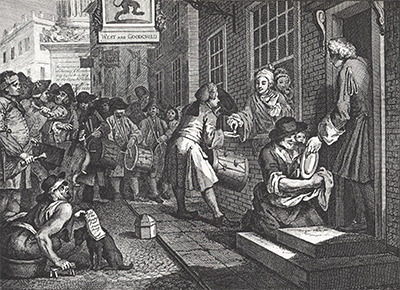The Industrious 'Prentice out of his Time, & Married to his Master's Daughter was finished in 1747 during the peak of the Rococo style of Baroque drawing methods, by one of the connoisseurs of Rococo, William Hogarth.
This engraving itself is Plate 6 of a series of twelve-plate, plot-linked engravings made by Hogarth that he titled Industry and Idleness. Together, the twelve plates tell a story of the rewards that await hard work and diligence, and of despair and ruin as the inevitable future of the lazy. Hogarth was a proponent of such plot-linked, readable images. He is considered one of the formative influences on the creation of comics and graphic novels.
This particular 26.4 × 34.7 cm plate depicts events the morning after the wedding of the industrious apprentice, one the two lead characters of Industry and Idleness. The bride and the groom can be seen on the left, leaning out of a window. The groom Francis, holding a cup without a handle, is paying the master-drummer of the band that presumably played at their wedding.
The rest of the band stand playing in the left background. At the front door, a footman is distributing the remnants of last night's table to a woman with a child behind her shoulder. On the left. two butchers can be seen standing with bones and a cleaver, one observing the scene, the other elbowing out the French viol of the band. Below them, on the bottom left, a beggar is singing a new song, Jesse, or the Happy Pair while sitting in a shallow tub. This figure probably represents a well-known disabled beggar in Hogarth's day called Philip in the Tub.
The gradual bluntness of the figures in the background shows Hogarth's tendency to mimic depth of field. Some buildings loom in the background. One of them has the sign "WEST and GOODCHILD", indicating that Frances has completed his apprenticeship under his master, and has now partnered with him. The other building is the London Monument commemorating the burning of the Protestants "by the Treachery of the Popish Faction." The picture is annotated by a signet entitled "Proverbs CH:XII. Ver:4. The Virtuous Woman is a Crown to her Husband." This plate, along with the entire series of Industry and Idleness currently resides at the British Museum.




